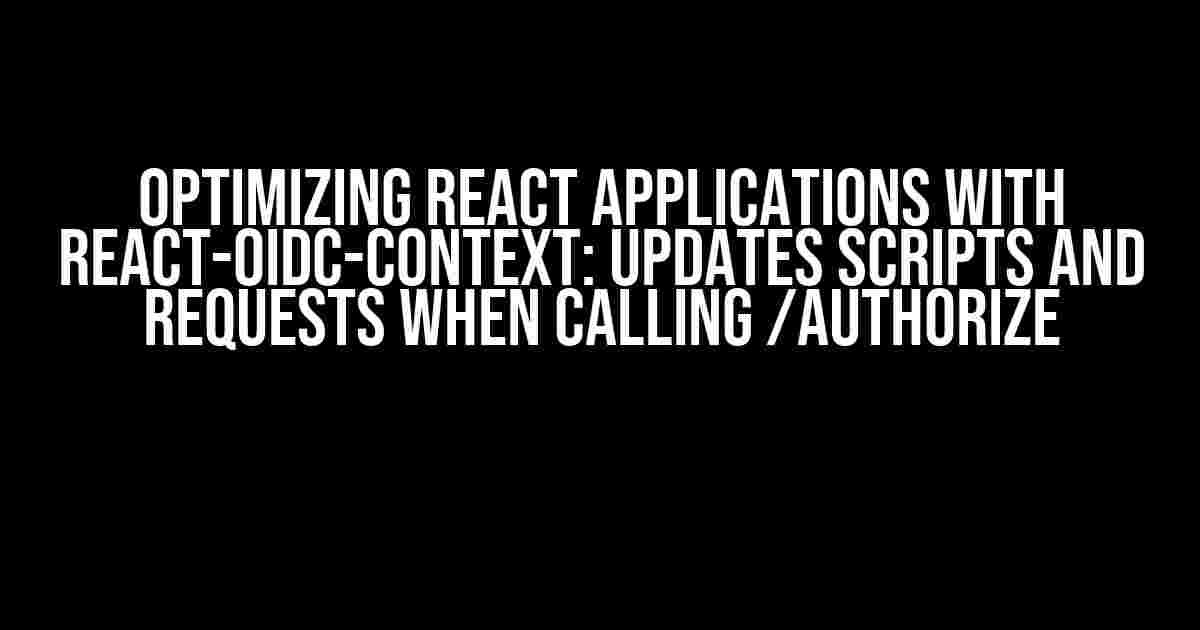When building a React application that requires authentication, developers often rely on OpenID Connect (OIDC) to manage user identities. One popular library for OIDC implementation in React is react-oidc-context. In this article, we will delve into the inner workings of react-oidc-context and explore how it updates scripts and requests when calling the `/authorize` endpoint.
What is react-oidc-context?
How react-oidc-context Handles /authorize Requests
When a user initiates an authentication flow in a React application that utilizes react-oidc-context, the library takes care of redirecting the user to the OIDC provider’s `/authorize` endpoint. This endpoint is responsible for authenticating the user and redirecting them back to the application with an authorization code.
Script Updates
When react-oidc-context calls the `/authorize` endpoint, it updates the scripts in the application to include the necessary OIDC-related scripts. These scripts are responsible for handling the authentication flow and managing the user’s session. By dynamically updating the scripts, react-oidc-context ensures that the application remains secure and compliant with OIDC standards.
Request Updates
In addition to updating scripts, react-oidc-context also updates the requests sent to the OIDC provider. When calling the `/authorize` endpoint, react-oidc-context generates a request that includes all the necessary parameters, such as the client ID, redirect URI, and scope. This ensures that the OIDC provider receives all the required information to authenticate the user and generate an authorization code.
Benefits of Using react-oidc-context
- Easy OIDC implementation: react-oidc-context provides a simple and intuitive way to integrate OIDC into React applications.
- Secure authentication: react-oidc-context ensures that the application remains secure and compliant with OIDC standards.
- Faster development: With react-oidc-context, developers can focus on building the application rather than worrying about the underlying OIDC implementation.
Conclusion
In conclusion, react-oidc-context is a powerful library that simplifies OIDC implementation in React applications. By understanding how react-oidc-context updates scripts and requests when calling the `/authorize` endpoint, developers can leverage its full potential to build secure and scalable applications. With its ease of use, security, and speed, react-oidc-context is an ideal choice for any React application that requires OIDC authentication.
Frequently Asked Question
Get the inside scoop on how react-oidc-context updates scripts and requests when calling /authorize!
What happens when I call /authorize with react-oidc-context?
When you call /authorize with react-oidc-context, it triggers an update to the oidc scripts and requests. This ensures that your application is synced with the latest authentication flows and security protocols, keeping your users safe and secure!
What kind of updates are made to the scripts and requests?
When react-oidc-context updates the scripts and requests, it refreshes the oidc configuration, updates the authentication tokens, and re-syncs the application state with the latest user authentication status. This ensures that your app is always up-to-date and ready to handle the latest security requirements.
Why does react-oidc-context need to update scripts and requests on /authorize call?
React-oidc-context updates scripts and requests on /authorize call to ensure that your application is compliant with the latest OIDC standards and security protocols. This is crucial to maintain the trust and security of your users’ data and prevent potential security breaches.
What are the benefits of react-oidc-context updating scripts and requests on /authorize call?
By updating scripts and requests on /authorize call, react-oidc-context ensures that your application remains secure, compliant, and scalable. This also enables you to provide a seamless and trusted user experience, which is critical for building trust and loyalty with your users.
How does react-oidc-context handle edge cases during script and request updates?
React-oidc-context is designed to handle edge cases gracefully, ensuring that your application remains stable and secure even in unusual scenarios. It uses robust error handling and fallback mechanisms to minimize potential disruptions and ensure a smooth user experience.

